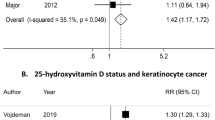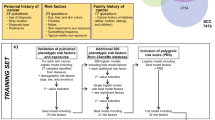Abstract
Objective:
To investigate the association between total alcohol intake and intake of different types of alcoholic beverages in relation to the risk of basal cell (BCC) and squamous cell (SCC) carcinoma of the skin.
Design:
Prospective cohort study.
Setting:
Follow-up data from a community-based skin cancer study in Australia.
Subjects:
Randomly selected sample of 1360 adult residents of the township of Nambour who completed a food frequency questionnaire in 1992 and were monitored for BCC and SCC until 31 December 2002.
Results:
No significant association was found between overall BCC or SCC risk and total alcohol intake, or intake of beer, white wine, red wine or sherry and port. However, among those with a prior skin cancer history, there was a significant doubling of risk of SCC for above-median consumption of sherry and port (multivariable adjusted relative risk 2.46, 95% confidence interval 1.06–5.72) compared with abstainers.
Conclusions:
There are no associations between first occurrence of skin cancers and alcoholic beverage consumption. People with a history of skin cancer who consume above-average quantities of sherry or port may be at a raised risk of SCC, although replication of these findings in different study populations is needed to confirm this possible role of specific alcoholic beverages in secondary keratinocytic skin cancer risk.
This is a preview of subscription content, access via your institution
Access options
Subscribe to this journal
Receive 12 print issues and online access
$259.00 per year
only $21.58 per issue
Buy this article
- Purchase on Springer Link
- Instant access to full article PDF
Prices may be subject to local taxes which are calculated during checkout
Similar content being viewed by others
References
Almahroos M, Kurban A (2004a). Ultraviolet carcinogenesis in nonmelanoma skin cancer Part II: review and update on epidemiologic correlations. SKINmed 3, 132–139.
Almahroos M, Kurban AK (2004b). Ultraviolet carcinogenesis in nonmelanoma skin cancer. Part I: Incidence Rates in Relation to Geographic Locations and in Malignant Populations. SKINmed 3, 29–35.
Benedetti A, Parent ME, Siemiatycki J (2006). Consumption of alcoholic beverages and risk of lung cancer: results from two case–control studies in Montreal, Canada. Cancer Causes Control 17, 469–480.
Christenson LJ, Borrowman TA, Vachon CM, Tollefson MM, Otley CC, Weaver AL et al. (2005). Incidence of basal cell and squamous cell carcinomas in a population younger than 40 years. JAMA 294, 681–690.
Diepgen TL, Mahler V (2002). The epidemiology of skin cancer. Br J Dermatol 146 (Suppl 61), 1–6.
Eedy DJ (2000). Non-melanoma skin cancer and the ‘new National Health Service’: implications for U.K. dermatology? Br J Dermatol 142, 397–399.
Food Standards Australia New Zealand (1995). Nuttab95: Nutrient data table for use in Australia.
Freedman DM, Sigurdson A, Doody MM, Mabuchi K, Linet MS (2003). Risk of basal cell carcinoma in relation to alcohol intake and smoking. Cancer Epidemiol Biomarkers Prev 12, 1540–1543.
Fung TT, Hunter DJ, Spiegelman D, Colditz GA, Rimm EB, Willet WC (2002). Intake of alcohol and alcoholic beverages and the risk of basal cell carcinoma of the skin. Cancer Epidemiol Biomarkers Prev 11, 1119–1122.
Garcia-Falcon MS, Simal-Gandara J (2005). Determination of polycyclic aromatic hydrocarbons in alcoholic drinks and the identification of their potential sources. Food Addit Contamin 22, 791–797.
Gerhauser C (2005). Beer constituents as potential cancer chemopreventive agents. Eur J Cancer 41, 1941–1954.
Green A, Battistutta D (1990). Incidence and determinants of skin cancer in a high-risk Australian population. Int J Cancer 46, 356–361.
Green A, Battistutta D, Hart V, Leslie D, Marks G, Williams G et al. (1994). The Nambour Skin Cancer and Actinic Eye Disease Prevention Trial: design and baseline characteristics of participants. Control Clin Trials 15, 512–522.
Green A, Battistutta D, Hart V, Leslie D, Weedon D (1996). Skin cancer in a subtropical Australian population: incidence and lack of association with occupation. The Nambour Study Group. Am J Epidemiol 144, 1034–1040.
Green A, Leslie D, Weedon D (1988). Diagnosis of skin cancer in the general population: clinical accuracy in the Nambour survey. Med J Aust 148, 447–450.
Green A, Williams G, Neale R, Hart V, Leslie D, Parsons P et al. (1999). Daily sunscreen application and betacarotene supplementation in prevention of basal-cell and squamous-cell carcinomas of the skin: a randomised controlled trial. Lancet 28, 723–729.
Hertog MGL, Hollman PCH, Katan MB (1992). Content of potentially anticarcinogenic flavonoids of 28 vegetables and 9 fruits commonly consumed in the Netherlands. J Agric Food Chem 40, 2379–2383.
Hughes MC, Pols JCvd, Marks GC, Green AC (2006). Food intake and risk of squamous cell carcinoma of the skin in a community: the Nambour skin cancer cohort study. Int J Cancer 119, 1953–1960.
Kune GA, Bannerman S, Field B, Watson LF, Cleland H, Merenstein D et al. (1992). Diet, alcohol, smoking, serum beta-carotene, and vitamin A in male nonmelanocytic skin cancer patients and controls. Nutr Cancer 18, 237–244.
Lambert JD, Hong J, Yang G, Liao J, Yang CS (2005). Inhibition of carcinogenesis by polyphenols: evidence from laboratory investigations. Am J Clin Nutr 81, 284s–290s.
Marchand LL, Saltzman BS, Hankin JH, Wilkens LR, Franke AA, Morris SJ et al. (2006). Sun Exposure, Diet, and Melanoma in Hawaii Caucasians. Am J Epidemiol (E-pub ahead of print).
Marks GC, Hughes MC, Van der Pols JC (2006). The effect of personal characteristics on the validity of nutrient intake estimates using a food-frequency questionnaire. Public Health Nutr 9, 394–402.
Masters JA (2005). Moderate drinking and cardiovascular disease. Annu Rev Nurs Res 23, 65–97.
McNaughton SA, Marks GC, Gaffney P, Williams G, Green AC (2005). Antioxidants and basal cell carcinoma of the skin: a nested case–control study. Cancer Causes Control 16, 609–618.
Merimsky O, Inbar M (1999). Alcohol intake-associated skin and mucosal cancer. Clin Dermatol 17, 447–455.
Mukamal KJ (2006). Alcohol consumption and self-reported sunburn: a cross-sectional, population-based survey. J Am Acad Dermatol 55, 584–589.
National Health and Medical Research Council (2003). Food for Health – Dietary Guidelines for Australian Adults: Commonwealth of Australia.
Peterson NB, Trentham-Dietz A, Newcomb PA, Chen Z, Hampton JM, Willett WC et al. (2006). Alcohol consumption and ovarian cancer risk in a population-based case–control study. Int J Cancer 119, 2423–2427.
Ramos J, Villa J, Ruiz A, Amstrong R, Matta J (2004). UV dose determines key characteristics of nonmelanoma skin cancer. Cancer Epidemiol Biomarkers Prev 13, 2006–2011.
Sahl WJ, Glore S, Garrison P, Oakleaf K, Johnson SD (1995). Basal cell carcinoma and lifestyle characteristics. Int J Dermatol 34, 398–402.
Sawyer-Sommers M (2005). Measurement of alcohol consumption: issues and challenges. Annu Rev Nurs Res 23, 27–64.
Soleas GJ, Grass L, Josephy PD, Goldberg DM, Diamandis EP (2002). A comparison of the anticarcinogenic properties of four red wine polyphenols. Clin Biochem 35, 119–124.
Staples MP, Elwood M, Burton RC, Williams JL, Marks R, Giles GG (2006). Non-melanoma skin cancer in Australia: the 2002 national survey and trends since 1985. Med J Aust 184, 6–10.
Stern RS (1999). The mysteries of geographic variability in nonmelanoma skin cancer incidence. Arch Dermatol 135, 843–844.
Thygesen LC, Albertsen K, Johansen C, Bronbaek M (2005). Cancer incidence among Danish brewery workers. Int J Cancer 116, 774–778.
United States Department of Agriculture (2003). USDA Database for the Flavonoid Content of Selected Foods.
Valery PC, Neale R, Williams G, Pandeya N, Siller G, Green A (2004). The effect of skin examination surveys on the incidence of basal cell carcinoma in a Queensland community sample: a 10-year longitudinal study. J Invest Dermatol Symp Proc 9, 148–151.
Willett WC (1998). Nutritional Epidemiology. Oxford University Press: New York.
Zou G (2004). A modified poisson regression approach to prospective studies with binary data. Am J Epidemiol 159, 702–706.
Acknowledgements
We thank the participants of the Nambour skin cancer study for their continued interest and support. We also thank Professor Gail Williams for her statistical support. Jolieke van der Pols was funded by a NHMRC Capacity Building Grant in Population Health Research (Grant number: 252834). This study was supported by the National Health and Medical Research Council of Australia and World Cancer Research Fund International.
Author information
Authors and Affiliations
Corresponding author
Additional information
Guarantors: JC van der Pols and AC Green.
Contributors: TMRA analysed the data and wrote the paper, JCvdP supported the analyses and wrote the paper, MCH and TI supported the analyses and assisted in writing the paper, GCM and ACG originated and designed the study and assisted in writing the paper.
Rights and permissions
About this article
Cite this article
Ansems, T., van der Pols, J., Hughes, M. et al. Alcohol intake and risk of skin cancer: a prospective study. Eur J Clin Nutr 62, 162–170 (2008). https://doi.org/10.1038/sj.ejcn.1602717
Received:
Revised:
Accepted:
Published:
Issue Date:
DOI: https://doi.org/10.1038/sj.ejcn.1602717
Keywords
This article is cited by
-
Epidemiology of Keratinocyte Carcinoma
Current Dermatology Reports (2017)
-
Alcohol consumption and risk of melanoma and non-melanoma skin cancer in the Women’s Health Initiative
Cancer Causes & Control (2014)
-
Intake of Alcohol May Modify the Risk for Non-Melanoma Skin Cancer: Results of a Large Danish Prospective Cohort Study
Journal of Investigative Dermatology (2012)



